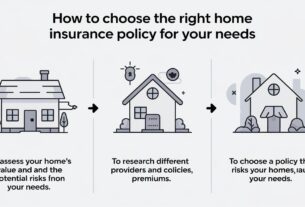Introduction to home insurance is essential for every homeowner, as it provides financial protection against unforeseen events such as natural disasters, theft, and accidents. The Ultimate Guide to Home Insurance: What You Need to Know will walk you through the process of choosing the right policy for your needs. Home insurance is a vital investment for any homeowner, and understanding the ins and outs of home insurance policies can save you from financial distress.
Home insurance policies vary in terms of coverage, premium, and deductible. It’s crucial to assess your needs and budget before selecting a policy. Homeowners should consider factors such as the value of their property, location, and potential risks when choosing a policy. Additionally, it’s essential to research and compares different insurance providers to find the best fit for your needs. By doing so, you can ensure that you’re adequately protected in the event of an unexpected incident.
Home insurance is not just about protecting your property; it’s also about protecting your finances. Without adequate insurance coverage, you may be left with significant out-of-pocket expenses in the event of a disaster or accident. Moreover, home insurance can provide liability coverage, which can protect you in case someone is injured on your property. With so many insurance providers and policies available, it can be overwhelming to choose the right one. However, with the right guidance, you can make an informed decision and ensure that your home and finances are protected.
Understanding Home Insurance Policies
Understanding home insurance policies is crucial for making an informed decision. Home insurance policies typically include several components, such as dwelling coverage, personal property coverage, liability coverage, and additional living expenses coverage. Dwelling coverage protects the structure of your home, including the foundation, walls, and roof. Personal property coverage, on the other hand, covers your personal belongings, such as furniture, clothing, and electronics. Liability coverage provides protection in case someone is injured on your property, while additional living expenses coverage helps cover the cost of temporary housing if your home is damaged or destroyed.
When choosing a home insurance policy, it’s essential to consider the type of coverage you need. There are several types of home insurance policies, including HO-1, HO-2, HO-3, and HO-5. HO-1 is a basic policy that covers only the structure of your home, while HO-2 and HO-3 provide more comprehensive coverage. HO-5, on the other hand, is a premium policy that offers the most extensive coverage. It’s crucial to assess your needs and budget before selecting a policy, as well as to research and compare different insurance providers to find the best fit for your needs.
Types of Home Insurance Policies
There are several types of home insurance policies available, each with its own unique features and benefits. HO-1, also known as a basic form policy, is the most basic type of home insurance policy. It covers only the structure of your home and provides limited coverage for personal property. HO-2, on the other hand, is a broad form policy that provides more comprehensive coverage for your home and personal property. HO-3, also known as a special form policy, is the most common type of home insurance policy and provides extensive coverage for your home and personal property. HO-5, also known as a comprehensive form policy, is a premium policy that offers the most extensive coverage for your home and personal property.
How to Choose the Right Home Insurance Policy
Choosing the right home insurance policy can be overwhelming, but there are several factors to consider. First and foremost, it’s essential to assess your needs and budget. Consider the value of your property, location, and potential risks when choosing a policy. Additionally, research and compare different insurance providers to find the best fit for your needs. Look for insurance providers that offer competitive rates, excellent customer service, and a wide range of coverage options. It’s also essential to read reviews and ask for referrals from friends and family members to get a sense of an insurance provider’s reputation and reliability.
When choosing a home insurance policy, it’s also essential to consider the deductible and premium. The deductible is the amount you pay out-of-pocket in the event of a claim, while the premium is the annual cost of the policy. A higher deductible can lower your premium, but it’s essential to ensure that you can afford the deductible in the event of a claim. Moreover, consider the coverage limits and exclusions of the policy. Make sure that the policy provides adequate coverage for your home and personal property, and that there are no exclusions that could leave you vulnerable to financial loss.
Factors to Consider When Choosing a Home Insurance Policy
There are several factors to consider when choosing a home insurance policy. First and foremost, it’s essential to consider the value of your property and location. If you live in an area prone to natural disasters, such as earthquakes or hurricanes, you may need to purchase additional coverage. Additionally, consider the potential risks associated with your property, such as a swimming pool or trampoline. It’s also essential to research and compare different insurance providers to find the best fit for your needs. Look for insurance providers that offer competitive rates, excellent customer service, and a wide range of coverage options.
Home Insurance Coverage Options
Home insurance coverage options vary depending on the policy and insurance provider. Most home insurance policies include dwelling coverage, personal property coverage, liability coverage, and additional living expenses coverage. Dwelling coverage protects the structure of your home, including the foundation, walls, and roof. Personal property coverage, on the other hand, covers your personal belongings, such as furniture, clothing, and electronics. Liability coverage provides protection in case someone is injured on your property, while additional living expenses coverage helps cover the cost of temporary housing if your home is damaged or destroyed.
Additional coverage options may include flood insurance, earthquake insurance, and umbrella insurance. Flood insurance provides protection against flood damage, which is not typically covered under a standard home insurance policy. Earthquake insurance, on the other hand, provides protection against earthquake damage, which can be devastating in certain areas. Umbrella insurance provides additional liability coverage, which can protect you in case of a lawsuit. It’s essential to assess your needs and budget before adding additional coverage options to your policy.
Types of Additional Coverage Options
There are several types of additional coverage options available, each with its own unique features and benefits. Flood insurance, for example, provides protection against flood damage, which can be devastating in certain areas. Earthquake insurance, on the other hand, provides protection against earthquake damage, which can be catastrophic in certain areas. Umbrella insurance provides additional liability coverage, which can protect you in case of a lawsuit. Other additional coverage options may include coverage for jewelry, fine art, and collectibles. It’s essential to assess your needs and budget before adding additional coverage options to your policy.
How to Save Money on Home Insurance
Saving money on home insurance requires some research and effort, but there are several ways to reduce your premium. First and foremost, it’s essential to shop around and compare rates from different insurance providers. Look for insurance providers that offer discounts for bundling policies, such as home and auto insurance. Additionally, consider increasing your deductible, which can lower your premium. However, ensure that you can afford the deductible in the event of a claim.
Moreover, consider installing safety features, such as smoke detectors and security systems, which can reduce your premium. Some insurance providers offer discounts for homes with these features. It’s also essential to maintain a good credit score, as insurance providers often use credit scores to determine premiums. Additionally, consider working with an independent insurance agent, who can help you find the best policy for your needs and budget.
Discounts and Incentives
There are several discounts and incentives available for home insurance policyholders. Many insurance providers offer discounts for bundling policies, such as home and auto insurance. Additionally, some insurance providers offer discounts for homes with safety features, such as smoke detectors and security systems. Other discounts may include discounts for nonsmokers, retirees, and military personnel. It’s essential to research and compare different insurance providers to find the best discounts and incentives for your needs and budget.
Home Insurance Claims Process
The home insurance claims process can be overwhelming, but it’s essential to understand the steps involved. First and foremost, it’s essential to contact your insurance provider as soon as possible after a loss or damage. Provide detailed documentation, including photos and videos, to support your claim. Your insurance provider will then assign an adjuster to assess the damage and determine the extent of the loss.
Once the adjuster has assessed the damage, your insurance provider will provide a settlement offer. It’s essential to review the offer carefully and ensure that it covers all the damages. If you’re not satisfied with the offer, you can negotiate with your insurance provider or seek the help of a public adjuster. Additionally, it’s essential to keep detailed records of all correspondence and communication with your insurance provider.
What to Expect During the Claims Process
During the claims process, you can expect to work closely with your insurance provider and adjuster. The adjuster will assess the damage and determine the extent of the loss, and your insurance provider will provide a settlement offer. It’s essential to review the offer carefully and ensure that it covers all the damages. Additionally, be prepared to provide detailed documentation, including photos and videos, to support your claim. It’s also essential to keep detailed records of all correspondence and communication with your insurance provider.
Conclusion
In conclusion, home insurance is a vital investment for any homeowner. Understanding home insurance policies, coverage options, and the claims process can save you from financial distress. By assessing your needs and budget, researching and comparing different insurance providers, and considering additional coverage options



